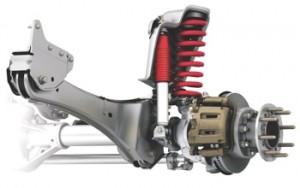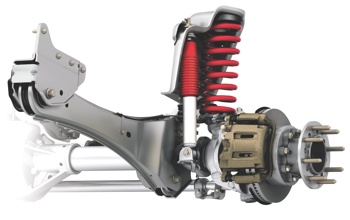Twin tube shocks and struts have been used as OE on most vehicles for many years. In recent years, though, we’ve also seen more monotube shocks and struts being used as OE dampers on sports and performance vehicles.
So what’s the difference and what are the advantages and disadvantages of each design?

In 1932, the Hudson Motor Car Co. was the first automaker to equip its cars with four direct-acting hydraulic shocks. Other automakers, such as Auburn, Reo, Chrysler, Packard and Terraplane, soon followed suit. In 1949, Ford changed to direct-acting hydraulic shocks, followed by Chevrolet in 1950.
In a twin-tube direct-acting shock, there is an inner tube for the piston cylinder and an outer tube that serves as a fluid reservoir. Valves in the piston and in the bottom of the shock control fluid flow in both directions and determine the dampening characteristics of the shock.
During the compression stroke when the piston moves down, some fluid flows through the piston valve from the lower chamber below the piston to the upper chamber above the piston. At the same time, some fluid in the lower chamber is also displaced through the valve in the bottom of the shock into the outer reservoir. Because fluid is incompressible, if there were no valving in the piston or the bottom of the shock, the piston would hydrolock as if it had hit a solid wall.
So the piston has to have orifices and/or some type of valving that allows the piston to move through the liquid. The valving at the bottom acts sort of like a safety valve and allows excess pressure in the lower chamber to vent into the reservoir when the vehicle hits a hard bump. The valve is usually velocity-sensing, which means it doesn’t open unless there is a sudden and sharp increase in pressure.
Piston size is also a factor. The larger the bore size, the greater the volume of fluid that’s displaced with every stroke of the piston inside the shock – which provides greater dampening ability. Thus, heavy-duty shocks typically have larger bore diameters than standard shocks.
During the extension cycle when the suspension undergoes rebound and pulls the shock out, the upward movement of the piston generates pressure in the upper chamber as it pushes through the fluid. The piston also sucks fluid back into the lower chamber from the reservoir when the valving in the bottom of the shock opens.
By using staged valving, the rate at which fluid moves between the upper and lower chambers, and the lower chamber and the outer reservoir can be carefully controlled to modify the dampening characteristics of the shock.
At low shock velocity, the valving can be set to allow easy movement between the chambers for a soft, boulevard-like ride. As shock velocity increases, the valving can change to create more resistance and stiffen the shock for improved ride control.
The valving can be designed to be equal in both directions (50/50 shocks), or much higher in one direction and lighter in the other (as in the 90/10 front shocks used in drag racing that extend easily to improve weight transfer to the rear wheels, but are slow to compress).
Shocks can also be calibrated so that they vent pressure and compress easily when hitting a bump, or vice versa. The valving can also be made variable with a mechanical dial (adjustable shocks) or a solenoid that changes the valving (electronic shocks).
Shock valving can also be modified by machining several small slits or grooves into the wall of the piston chamber. These grooves are positioned in the middle area of the shock where the piston spends most of its time. By allowing more fluid to bypass the piston, the grooves provide a smoother ride in the comfort zone. But when the piston travels up or down beyond this range, it encounters more resistance and provides stiffer control.
Something else to keep in mind is that a shock absorber converts the energy of motion into heat. The faster a shock is pumped up and down, the more resistance it creates and the more heat it generates. The heat is dissipated into the fluid, the shock body and the surrounding air. On a rough road, a shock can get pretty hot. If the shock does not get adequate cooling, the oil can thin out and cause the shock to fade.
Cavitation & Foaming
If you’ve even seen a cutaway shock with a see-through glass or plastic piston chamber, you can see what happens to the fluid when the piston pumps up and down. At a relatively slow speed, the fluid just moves back and forth (not very interesting). But when you pump the shock up and down rapidly, air bubbles form behind the piston. Engineers call this cavitation, and it causes aeration and fluid foaming. The hydraulic fluid turns into a frothy mixture of air and oil that resembles a good head on a fresh glass of beer.
Fluid aeration and foaming is not a good thing inside a shock absorber because air is compressible and is much thinner than the liquid it displaces. Consequently, the shock starts to fade and provides much less resistance and ride control than it did before the fluid started to foam. On a rough road, this can cause a lot of tire bounce, loss of traction and even loss of handling control.
Gas-Charging
In 1956, a Frenchman named De Carbon found a solution for the foaming problem. He discovered that pressurizing the fluid with nitrogen, freon or air helped reduce foaming. He took his idea to the German shock manufacturer Bilstein and they patented a design for a single tube (monotube) shock with a high-pressure (360 psi) gas charge in the bottom of the shock. A floating piston separated the gas charge from the hydraulic fluid.
The original patent expired in 1971 and other companies soon developed similar designs. Gas-pressurized monotube and twin-tube shocks soon became popular in the aftermarket for racing and performance applications.
It wasn’t long before the automakers noticed the new technology and began equipping their vehicles with gas shocks and struts as OE. In 1982, the first OE gas-charged twin-tube shocks were used on the Lincoln Continental. The first adjustable gas-pressurized shocks were introduced 1979.
Twin-Tube Advantage
One of the advantages of a twin-tube gas pressurized shock is that less gas pressure can be used to prevent the fluid from foaming. Some twin-tube shocks contain as little as 35 psi, while others may contain as much as 100 psi to 150 psi. This eliminates the need to have a highly polished piston bore with a floating piston (which lowers manufacturing costs), and it allows a softer ride for everyday driving.
The gas charge in the top of the outer fluid reservoir works like a pressure cooker to prevent foaming. This significantly improves ride control performance by reducing fade, noise and roughness. It also allows more latitude in shock valving for a wider range of control compared to a conventional shock or strut.
The twin-tube shock is also less expensive to manufacture than a monotube shock because it does not require a high polished piston chamber, or a floating piston to separate the gas charge from the oil inside the shock.
Captions: Fluid aeration and foaming is not a good thing inside a shock absorber because air is compressible and is much thinner than the liquid it displaces.
Twin-tube shocks and struts typically have a smaller diameter rod when compared to monotube shocks.














